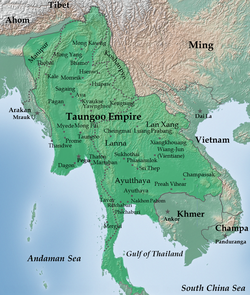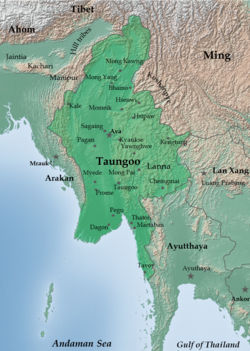Toungoo dynasty
Toungoo dynasty တောင်ငူမင်းဆက် taungnguumainn saat | |||||||||||||||||
|---|---|---|---|---|---|---|---|---|---|---|---|---|---|---|---|---|---|
| 1510–1752 | |||||||||||||||||
 Toungoo Empire at its greatest extent (1580) | |||||||||||||||||
 The restored Taungoo or Nyaungyan Dynasty c. 1650 | |||||||||||||||||
| Capital | Toungoo (Taungoo) (1510–39) Pegu (Bago) (1539–99) Ava (Inwa) (1599–1613) Pegu (Bago) (1613–35) Ava (Inwa) (1635–1752) | ||||||||||||||||
| Common languages | Official Burmese Regional
| ||||||||||||||||
| Religion | Official Theravada Buddhism Minority | ||||||||||||||||
| Government | Monarchy | ||||||||||||||||
• 1485-1530 | Mingyi Nyo | ||||||||||||||||
• 1530–50 | Tabinshwehti | ||||||||||||||||
• 1550–81 | Bayinnaung | ||||||||||||||||
• 1605–28 | Anaukpetlun | ||||||||||||||||
• 1629–48 | Thalun | ||||||||||||||||
• 1733–52 | Mahadhammaraza Dipadi | ||||||||||||||||
| Legislature | Restored Taungoo Empire | 1599–1752 | |||||||||||||||
• End of dynasty | 23 March 1752 | ||||||||||||||||
| Population | |||||||||||||||||
• Census | 1,982,000 - 2,313,000[ silver kyat | ||||||||||||||||
| |||||||||||||||||
| History of Myanmar |
|---|
 |
|
|
|
|
|
|
The Toungoo dynasty (
At its peak, the Toungoo Empire was the largest and strongest empire in Southeast Asia. However, it collapsed in the 18 years following Bayinnaung's death in 1581.The dynasty quickly regrouped under the leadership of
The kingdom entered a gradual decline due to the "palace rule" of its kings. Starting from the 1720s, the kingdom was beset with raids by the
History
King
Mingyi Nyo's son, King Tabinshwehti, unified most of Burma, consolidating his power and pushing southward, over-running the Irrawaddy Delta and crushing the Hanthawaddy capital of Bago. In 1544, Tabinshwehti was crowned as king of all Burma at the ancient capital of Bagan. By this time, the geopolitical situation in Southeast Asia had changed dramatically. The Shan gained power in a new kingdom in the north, the Ayutthaya Kingdom had established itself as a suzerain power around the Chao Phraya river basin, while the Portuguese Empire had arrived in the south and conquered Malacca.

With the coming of
Bayinnaung's Empire
Tabinshwehti's brother-in-law,
Restored Taungoo
Faced with rebellion by several cities and renewed Portuguese incursions, the Toungoo rulers withdrew from southern Burma and founded a second dynasty at Ava, the Nyaungyan or Restored Taungoo Dynasty (1597–1752). Bayinnaung's grandson, Anaukpetlun (1605–1628), once again reunited Burma in 1613 and decisively defeated Portuguese attempts to take over Burma. Anaukpetlun's successor Thalun (1629–1648) rebuilt the war torn country. Based on Thalun's revenue inquest in 1635, the Irrawaddy valley's population was estimated to be around 2 million.[2]
The dynasty survived for another century and a half until the death of Mahadhammayaza in 1752. Encouraged by the French in India, Bago finally rebelled against Inwa, further weakening the state, which fell in 1752. The downfall of the Toungoo dynasty has been more broadly ascribed to institutional weaknesses in the capital, which intensified factionalism and succession disputes, and the uneven impact of growing trade and potential price inflation, on the elite's income streams.[3]
Family tree
| Mingyi Swe V. of Toungoo ~1490s–1549 r.1540–1549 | Yaza Dewi ~1500-? Queen | Mingyi Nyo 1459–1530 r. 1510–1530 | Yadana Dewi 1490s-? Central Palace Queen | Soe Min Hteik-Tin ~1460s-~1530s Chief queen | |||||||||||||||||||||||||||||||||||||||||||||||||||||||||||||||||
| Dhamma Dewi ~1514/15-1580s Chief queen | Tabinshwehti 1516–1550 r. 1530–1550 | Khay Ma Naw Chief queen | Atula Thiri ~1518–1568 Chief queen | Bayinnaung 1516–1581 r. 1550–1581 | Khin Pyezon ~1530s-? Queen | Shin Htwe Myat | Sanda Dewi 1517/18–1580s? Chief queen | ||||||||||||||||||||||||||||||||||||||||||||||||||||||||||||||
| Hanthawaddy Mibaya ~1536–1606 Chief queen | Nanda 1535–1600 r. 1581–1599 | Nyaungyan 1555–1605 r. 1599–1605 | Khin Hpone Myint ~1560-1610s Chief queen | ||||||||||||||||||||||||||||||||||||||||||||||||||||||||||||||||||
| Atula Sanda Dewi Chief queen | Anaukpetlun 1578–1628 r. 1605–1628 | Khin Myo Myat | |||||||||||||||||||||||||||||||||||||||||||||||||||||||||||||||||||
| Min Lat | Mingala Dewi | Thalun 1584–1648 r. 1629–1648 | Khin Myo Sit | Khin Myat Hset | Minye Deibba 1608–1629 r. 1628–1629 | Khin Hnin Paw of Kengtung Chief queen | |||||||||||||||||||||||||||||||||||||||||||||||||||||||||||||||
| Ne Myo Ye Kyaw | Khin Ma Min Sit | Atula Sanda Dewi Chief queen | Pindale 1608–1661 r. 1648–1661 | Min Phyu Chief queen | Pye 1619–1672 r. 1661–1672 | Khin Ma Lat | |||||||||||||||||||||||||||||||||||||||||||||||||||||||||||||||
Minye Kyawhtin 1651–1698 r. 1673–1698 | Sanda Dewi | Narawara 1650–1673 r. 1672–1673 | |||||||||||||||||||||||||||||||||||||||||||||||||||||||||||||||||||
| Sanay 1673–1714 r. 1698–1714 | Maha Dewi Chief queen | ||||||||||||||||||||||||||||||||||||||||||||||||||||||||||||||||||||
| Taninganway 1689–1733 r. 1714–1733 | Mingala Dewi Chief queen | ||||||||||||||||||||||||||||||||||||||||||||||||||||||||||||||||||||
| Maha Dhamma Yaza 1714–1754 r. 1733–1752 | Nanda Dipadi Chief queen | ||||||||||||||||||||||||||||||||||||||||||||||||||||||||||||||||||||
Governance
During the Toungoo dynasty, the Burmese crown undertook a series of reforms that strengthened the stability and relative longevity of the dynasty. While the First Toungoo empire had established the precedent of stitching together independent kingdoms under a single monarch, Restored Toungoo monarchs more successfully subordinated lowland principalities under the Burmese throne's direct control.[3] Senior princes of these principalities were required to live at the Burmese capital under close supervision, and the ceremonial insignia of these provincial rulers was downgraded.[3] Other reforms included direct central control of provincial deputies, more effective links with provincial village chiefs, and expansion of the ahmudan system around the capital.[3] Beginning in 1635, the Burmese crown began to conduct comprehensive censuses, and consolidated access to provincial manpower and tax collections.[3] The Burmese monkhood in Upper Burma was also subject to more effective personnel and financial regulations.[3]
References
- ISBN 978-1-4008-5585-8. Archivedfrom the original on 26 September 2021. Retrieved 18 January 2021.
- ^ Dr. Than Tun (December 1968). "Administration Under King Thalun". Journal of Burma Research Society. 51, Part 2: 173–188.
- ^ ISBN 978-1-5017-3217-1. Archivedfrom the original on 3 June 2020. Retrieved 3 June 2020.
- Victor B. Lieberman, "Burmese Administrative Cycles: Anarchy and Conquest, c. 1580–1760", Princeton University Press, 1984.
